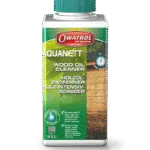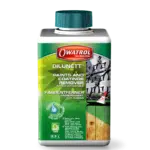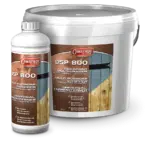In all cases, we’d recommend trying a sample to test for the touch time (this means working out how long it is going to take for the coatings to lift) before embarking on the whole job.
Stripping wood oils from fencing and cladding
 If your fence or cladding is coated with wood oils, we definitely recommend you strip them using Aquanett. It’s designed specifically for removing wood oils and it’s a gel formula so it’s easy to use on fences and cladding because it won’t run or sag.
If your fence or cladding is coated with wood oils, we definitely recommend you strip them using Aquanett. It’s designed specifically for removing wood oils and it’s a gel formula so it’s easy to use on fences and cladding because it won’t run or sag.

You need to neutralise the wood with Net-Trol after stripping your fencing or cladding to prevent the stripper from remaining active in the wood.
Stripping paint and opaque finishes from fencing or cladding

To use it on your fencing or cladding apply the the Dilunett, leave it to work and then rinse whilst scrubbing in the direction of the grain to remove the coating. After using Dilunett you will need to neutralise the wood with Net-Trol.
Before you start stripping the entire area you should first perform a touch test (this is the same regardless of the stripper you are planning to use). To do this you apply to the stripper to a small area and leave it to work. After a period of time you begin to scrub the edge to see if the coatings are lifting, if not leave it a little longer and try again.
Once the coating is lifting successfully you can record the amount of time it has been on and that is your touch time. This is approximately how long you can expect it to take for the rest of the surface – although this is of course dependent on the surface being coated evenly!
Uhoh – I’m not sure what my fence is coated with!

If you find that even after leaving the Dilunett for its full working time of 12 hours your coatings are still not lifting then we would suggest trying a sample of DSP 800. It’s a more powerful stripper which can even remove 2-pack paints but you don’t rinse it with water you have to use a scraper or scrubbing brush so it will be more onerous.
We hope you found this post on stripping your wood fencing helpful. If you have any other advice or top tips, please feel free to leave them in the comments below. We love hearing from you!
You can also follow us on Twitter, Facebook, Instagram or Pinterest at @OwatrolUK or find us under the hashtag #OwatrolUK





